Rosenwald School
A Rosenwald School was the name informally applied to over five thousand schools, shops, and teachers' homes in the United States which were built primarily for the education of African-Americans in the early 20th century. The need arose from the chronic underfunding of public education for African-American children in the South, who were required to attend segregated schools. Julius Rosenwald, an American clothier who became part-owner and president of Sears, Roebuck and Company, was the founder of The Rosenwald Fund, through which he contributed seed money for many of the schools and other philanthropic causes. To promote collaboration between white and black citizens, Rosenwald required communities to commit public funds to the schools, as well as to contribute additional cash donations. Millions of dollars were raised by African-American rural communities across the South to fund better education for their children. Despite Rosenwald's matching donations toward the construction of black schools, by the mid-1930s, white schools in the South were worth, per student, over five times what black schools were worth per student (in majority-black Mississippi, this ratio was more than 13 to one).[1]
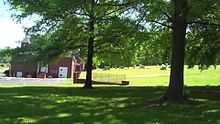
Julius Rosenwald
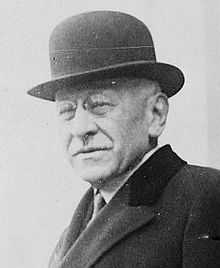
Julius Rosenwald (1862–1932) was a German-Jewish immigrant's son and became a clothier by trade, after learning the business from relatives in New York City. His first business went bankrupt; however, another he began in Chicago, Illinois became a leading supplier to Richard Sears' business. Sears, Roebuck and Company was a growing mail-order business which served many rural Americans. Anticipating demand by using the variations of sizes in American men and their clothing determined during the American Civil War, Rosenwald helped plan the growth in what many years later marketers would call "the softer side of Sears": clothing. In 1895, he became one of its investors, eventually serving as the president of Sears from 1908 to 1922. He was its chairman until his death in 1932.
After the 1906 reorganization of the Sears company as a public stock corporation by the financial services firm of Goldman Sachs, one of the senior partners, Paul Sachs, often stayed with the Rosenwald family at their home during his many trips to Chicago. Julius Rosenwald and Sachs would often discuss America's social situation, agreeing that the plight of African Americans was the most serious problem in the United States.
Sachs introduced Rosenwald to Booker T. Washington, the famed educator who in 1881 had been the first principal of the normal school which grew to become Tuskegee University in Alabama. Dr. Washington, who had gained the respect of many American leaders including U.S. President Theodore Roosevelt, had also obtained financial support from wealthy philanthropists such as Andrew Carnegie, George Eastman and Henry Huttleston Rogers. He encouraged Rosenwald, as he had others, to address the poor state of African-American education in the U.S.
In 1912, Rosenwald was asked to serve on the Board of Directors of Tuskegee, a position he also held for the remainder of his life. Rosenwald endowed Tuskegee so that Washington could spend less time traveling to seek funding and devote more time towards management of the school. As urged by Dr. Washington, Rosenwald provided funds for the construction of six small schools in rural Alabama, which were constructed and opened in 1913 and 1914 and overseen by Tuskegee.
Rosenwald Fund
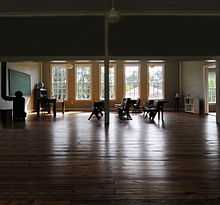
Julius Rosenwald and his family established The Rosenwald Fund in 1917 for "the well-being of mankind." Unlike other endowed foundations, which were designed to fund themselves in perpetuity, The Rosenwald Fund was intended to use all of its funds for philanthropic purposes. It donated over 70 million dollars to public schools, colleges and universities, museums, Jewish charities and black institutions before funds were completely depleted in 1948.
The school building program was one of the largest programs administered by the Rosenwald Fund. Using state-of-the-art architectural plans designed by professors at Tuskegee Institute,[2] the Fund spent more than four million dollars to build 4,977 schools, 217 teachers' homes, and 163 shop buildings in 883 counties in 15 states, from Maryland to Texas. The Rosenwald Fund used a system of matching grants. Black communities raised more than $4.7 million to aid in construction . These schools became known as "Rosenwald Schools." By 1932, the facilities could accommodate one- third of all African-American children in Southern schools. Research has found that the Rosenwald program accounts for a sizable portion of the educational gains of rural Southern blacks. This research also found significant effects on school attendance, literacy, years of schooling, cognitive test scores, and Northern migration, with gains highest in the most disadvantaged counties.[3]
Preservation
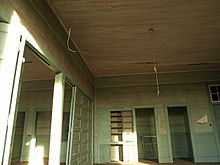
In some communities, surviving structures have been preserved because of the deep meaning they had for African-Americans as symbols of their leaders' and communities' dedication to education. Others were threatened by lack of funds in rural areas, changing style of education to consolidated and integrated schools, and other social changes. In 2002, the National Trust for Historic Preservation named Rosenwald Schools near the top of the country's most endangered places and created a campaign to raise awareness and money for preservation. At least 23 former Rosenwald Schools are listed on the National Register of Historic Places.[4]
Some schools have been put to new uses. Walnut Cove Colored School in Stokes County, North Carolina won a National Preservation Honor Award for its rehabilitation for use as a senior citizens' community center. The Hope Rosenwald School in Pomaria, South Carolina will be used as a community center, too. The Highland Park School in Prince George's County, Maryland had been in continuous use by the school system. It was recently renovated for use as a Headstart Center.
- Rosenwald Schools in the 21st Century
-

Arbeka Rosenwald School in Arbeka, Oklahoma
-
Cusseta Industrial High School in Cusseta, Georgia.
-
Douglass School in Lawton, Oklahoma
-
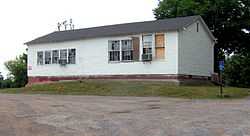
Free Hills Community Center in Free Hill, Tennessee
-
Rosenwald Hall in Lima, Oklahoma
-
Kiowa County Sep. #1 in Hobart, Oklahoma
-
Lincoln Grade School in Lehigh, Oklahoma
-
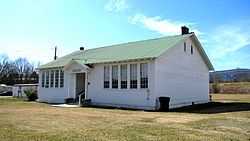
Lincoln School in Pikeville, Tennessee
-

Lockhart Vocational High School in Lockhart, Texas
-
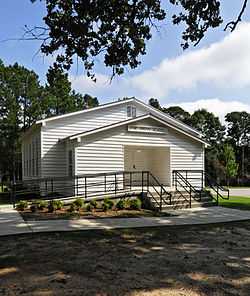
Pine Grove School in Richland County, South Carolina
-
Pleasant Hill School in McCurtain County, Oklahoma
-
Retreat Rosenwald School in Oconee County, South Carolina
-

Union School in Stella, Oklahoma
See also
- List of Rosenwald schools
- Jane Addams
- Grace Abbott
- Emil Hirsch
- Julian Mack
- Beauregard Parish Training School
References
- ↑ Neil R. McMillen, Dark Journey: Black Mississippians in the Age of Jim Crow, at 84 (University of Illinois Press 1990)
- ↑ "History of the Rosenwald School Program". National Trust for Historic Preservation. Retrieved December 14, 2013.
- ↑ Federal Reserve Bank of Chicago, The Impact of Rosenwald Schools on Black Achievement, September 2011
- ↑ "National Register Information System". National Register of Historic Places. National Park Service. 2009-03-13.
External links
| Wikimedia Commons has media related to Rosenwald schools. |
- Rosenwald Schools of South Carolina, An Oral History Exhibit
- Diane Granat, Saving the Rosenwald Schools
- Rosenwald Schools Initiative sponsored by the National Trust for Historic Preservation
- Rosenwald School Archives at Fisk University A searchable database of many of the Rosenwald Schools containing information and photos from when they were built
- History South: Rosenwald Schools
- Rosenwald Harlanites, Inc., non-profit organization created to preserve the legacy of the Rosenwald School in Harlan, Kentucky
- Shiloh Community Restoration Project, a non-profit organization created to restore the Shiloh-Rosenwald School
- Noble Hill Wheeler Memorial Center; restored 1923 Rosenwald school in NW Georgia
- Photographs of some Rosenwald Schools by Sarah Hoskins



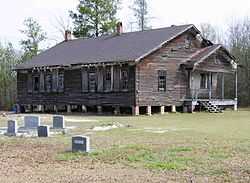

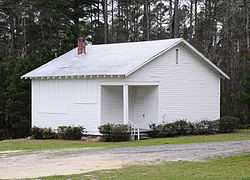






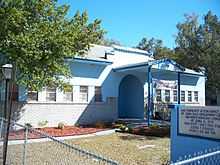
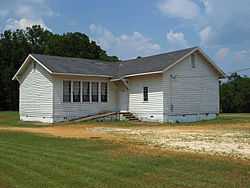







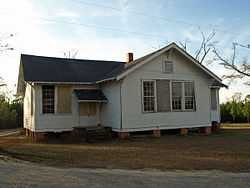
.jpg)